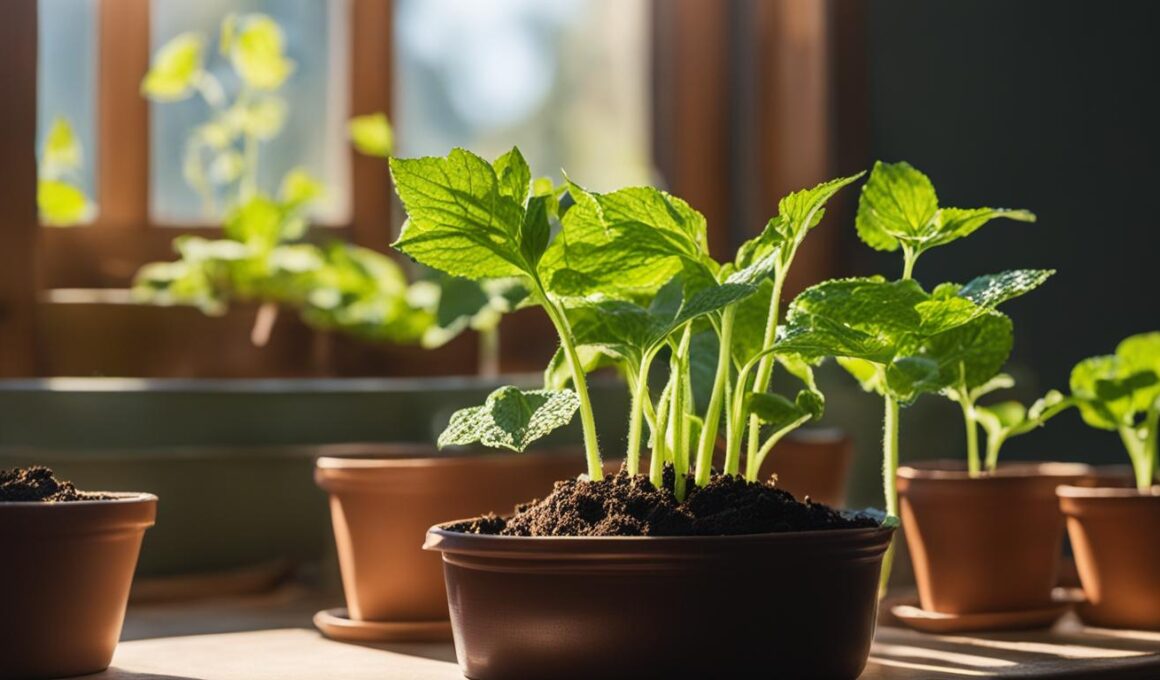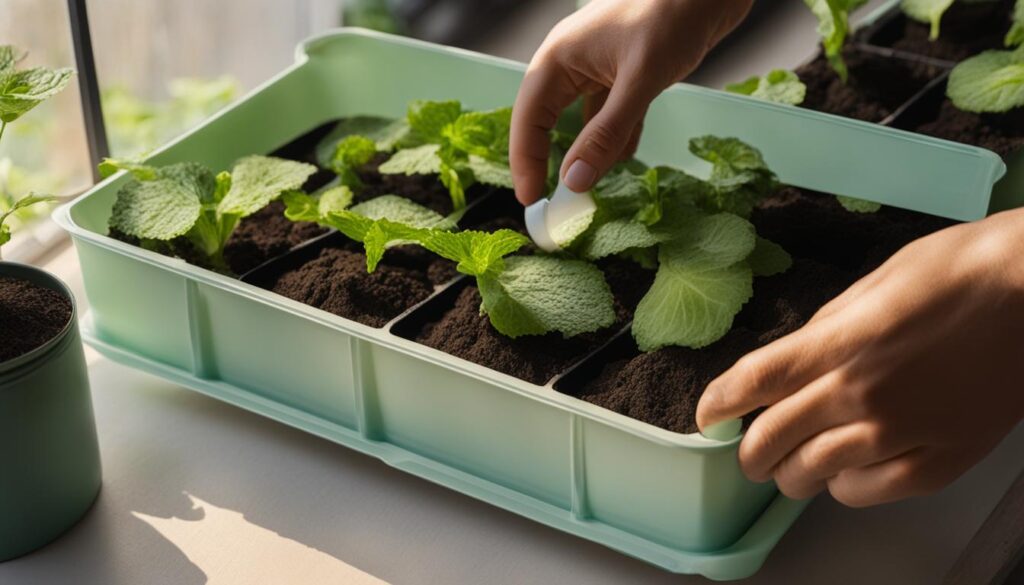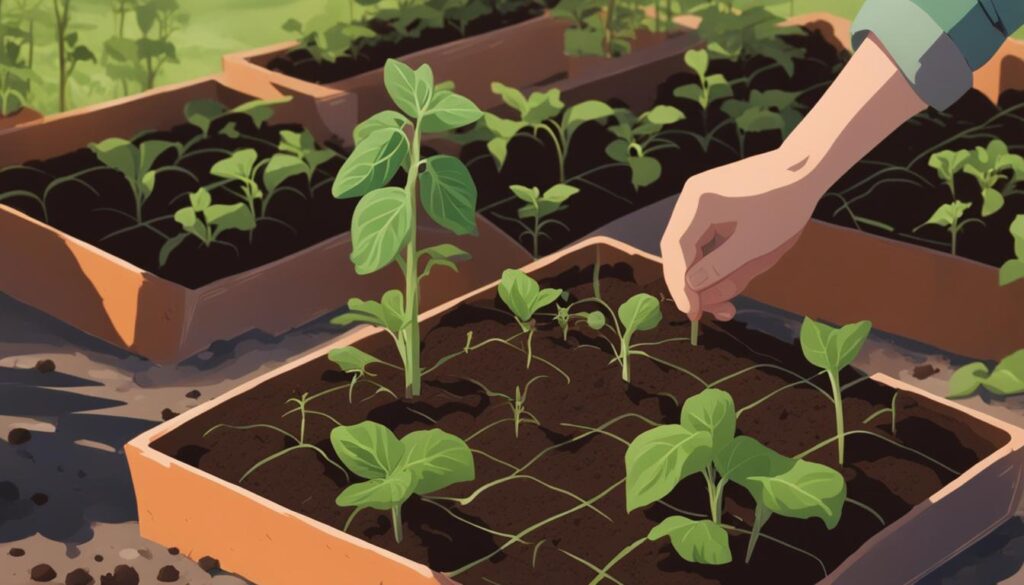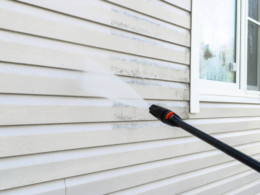Welcome to your guide on when to start cucumber seeds indoors. If you’re looking to maximize your growing season and cultivate healthy cucumber plants, starting seeds indoors is a great option. Cucumbers are versatile and easy to grow, with just a few considerations, such as hand pollination. In this guide, we’ll walk you through the optimal timing and care required to successfully start cucumber seeds indoors.
Post Summary
- Starting cucumber seeds indoors allows for an extended growing season.
- The best time to start cucumber seeds indoors is about two to three weeks before the last frost date.
- Provide warm temperatures, adequate light, and regular watering for successful seed germination and growth.
- Transplant seedlings outdoors after hardening them off and ensuring reliable warm weather.
- Cultivating cucumbers indoors gives you more control over temperature and planting time.
When to Start Cucumbers Indoors
If you’re looking to get a head start on your cucumber garden, starting your cucumbers indoors is the way to go. By starting your seeds indoors, you have more control over the growing conditions and can extend your growing season. But when is the best time to start cucumbers indoors?
The ideal time to start your cucumber seeds indoors is two to three weeks before the last frost date in your area. This timing allows your plants to develop strong roots and healthy growth before being transplanted outdoors. Starting your cucumbers indoors gives you a jump start on the growing season, allowing you to enjoy fresh cucumbers earlier in the year.
If you have the means to provide your cucumber seedlings with the necessary warmth and light, you can even start them earlier than two to three weeks before the last frost date. This can be achieved by using a heat mat or a grow light to create the ideal conditions for seed germination. However, it’s essential to ensure that your seedlings won’t be exposed to frost or extreme cold temperatures when it’s time to transplant them outdoors.
When to Start Cucumbers Indoors
“Starting your cucumbers indoors gives you a jump start on the growing season, allowing you to enjoy fresh cucumbers earlier in the year.”
By starting your cucumbers indoors, you can give your plants a head start and increase your chances of a successful cucumber harvest. Remember to follow the recommended timeline and provide your seedlings with the warmth, light, and moisture they need to thrive. With proper care and attention, you’ll be rewarded with delicious, homegrown cucumbers that you can enjoy all summer long.
| Factors | Starting Cucumbers Indoors | Direct Sowing |
|---|---|---|
| Control over growing conditions | High | Low |
| Extended growing season | Yes | No |
| Earlier harvest | Yes | No |
| Risk of frost damage | Low | High |
As shown in the table above, starting cucumbers indoors offers several advantages over direct sowing. With greater control over the growing conditions, an extended growing season, and the possibility of an earlier harvest, it’s no wonder many gardeners choose to start their cucumbers indoors. However, it’s important to weigh these factors against the potential risks and challenges to make the best decision for your specific gardening situation.
Planting Cucumber Seeds Indoors
To successfully start your cucumber seeds indoors, it’s important to provide them with the right conditions and care. Follow these steps to ensure healthy and vigorous seedlings:
- Choose small pots or containers with drainage holes to prevent water buildup. Fill them with a rich and nutritious soil mix that is well-draining.
- Plant one or two cucumber seeds per pot, burying them about half an inch deep. This ensures good germination and proper growth.
- Place the pots in a warm and sunny spot, such as a window sill, where the seedlings can receive adequate sunlight. If you don’t have a warm area, consider using a heat mat or a grow light to provide the necessary warmth and light.
- Keep the soil consistently moist but not overly saturated. Check the pots regularly for blocked drainage holes and adjust watering accordingly.
By following these steps, you’ll create an optimal environment for your cucumber seeds to germinate and grow into healthy seedlings ready for transplanting.
Tips for Choosing the Right Soil
The soil you use for planting cucumber seeds indoors should be rich in organic matter and well-draining. A good option is a commercially available potting mix formulated for seed starting. Alternatively, you can create your own mix by combining equal parts of peat moss, vermiculite, and perlite. This ensures proper drainage and provides the necessary nutrients for seed germination and early growth.
Providing a Warm and Sunny Spot
Cucumbers are warm-season plants that thrive in temperatures between 70 and 85 degrees Fahrenheit. To simulate these conditions indoors, choose a warm and sunny spot for your cucumber seedlings. A south-facing window sill is ideal as it receives the most sunlight throughout the day. If natural sunlight is limited, consider using a heat mat or a grow light to provide the necessary warmth and light for seed germination and healthy growth.
Caring for Cucumber Seeds Indoors
When caring for cucumber seeds indoors, there are a few key factors to keep in mind to ensure successful growth. One important aspect is providing adequate light for the seedlings. Cucumber seedlings require between six and eight hours of light each day to thrive. You can achieve this by placing the pots in a sunny window sill or by using artificial grow lights.
Watering is another crucial element of caring for cucumber seeds indoors. It’s important to keep the soil moist, but be cautious not to overwater as this can lead to root rot. The potting soil should be well-draining, and it’s recommended to check for blocked drainage holes to prevent water buildup. Daily watering is typically necessary to maintain the desired moisture level.
“Cucumber seedlings need between six and eight hours of light each day for optimal growth.”
To summarize, caring for cucumber seeds indoors involves providing adequate light and watering the seedlings regularly. With these proper care practices in place, you can ensure healthy and robust cucumber plants for successful cultivation.
Light Requirements for Cucumber Seeds
Light is essential for the growth and development of cucumber seedlings. When starting cucumber seeds indoors, it’s important to place them in a spot that receives plenty of sunlight or use artificial grow lights. Cucumber seedlings require between six and eight hours of light each day for optimal growth. This light exposure helps in the photosynthesis process, allowing the seedlings to produce energy and develop into healthy plants.
“Caring for cucumber seeds indoors involves providing adequate light and watering the seedlings regularly.”
If you’re using artificial grow lights, position them about six inches above the seedlings and keep them on for 14 to 16 hours each day. This mimics natural sunlight and provides the necessary light intensity for proper growth. Alternatively, if you’re relying on sunlight, place the pots in a sunny window sill or a location that receives direct sunlight for most of the day. Regularly rotate the pots to ensure even light distribution on all sides of the seedlings.
In conclusion, meeting the light requirements for cucumber seeds is crucial for their indoor care. Whether using natural sunlight or artificial grow lights, providing the seedlings with the required amount of light will promote healthy growth and result in thriving cucumber plants.
Transplanting Cucumber Seedlings Outdoors
Once your cucumber seedlings have spent three to four weeks growing indoors, they will be ready for transplanting outdoors. Before moving them to the garden, it’s important to harden off the seedlings. Hardening off is the process of gradually exposing the plants to outdoor conditions, allowing them to acclimatize to the elements. This reduces the risk of transplant shock and ensures a successful transition to the garden.
To begin the hardening off process, start by placing the seedlings outside for a few hours in a partially shaded area. Gradually increase their exposure to sunlight and extend the duration of time spent outdoors each day. Over the course of a week or two, the seedlings will become used to the outdoor conditions.
Once the cucumber seedlings are fully hardened off, it’s time to choose a suitable spot in the garden for transplanting. Cucumbers thrive in full sun and well-draining soil. Ensure the area has good drainage to prevent waterlogged roots. If your garden soil does not drain well, consider planting in raised beds or containers.
If you’re growing vining cucumber varieties, provide support such as trellises or stakes for the plants to climb. This helps maximize space and improves air circulation around the plants, reducing the risk of disease. When transplanting, dig a hole deep enough to accommodate the root ball of the seedling and gently place it in the hole. Backfill the hole with soil, firming it gently around the plant.
Ideal Growing Conditions for Cucumber Seedlings
| Aspect | Soil | Light | Watering |
|---|---|---|---|
| Sunny | Well-draining | Full sun (6-8 hours/day) | Regular, keeping soil moist but not waterlogged |
Once the seedlings are in the ground, continue to provide them with regular watering and monitor their growth. Cucumbers are heavy feeders, so consider incorporating organic fertilizer into the soil before transplanting or applying liquid fertilizer during the growing season.
By following these steps and providing suitable growing conditions, you’ll set your cucumber seedlings up for success in the garden. With proper care, you’ll soon be harvesting fresh, crisp cucumbers for salads and pickling.
Conclusion
Starting cucumber seeds indoors is the key to a successful cucumber cultivation. By beginning the process two to three weeks before the last frost date, you can maximize your growing season and ensure optimal results. Providing your seedlings with warm temperatures, adequate light, and regular watering is crucial for their healthy development.
Once your cucumber seedlings have been hardened off and the weather is reliably warm, it’s time to transplant them outdoors. Choose a suitable spot in your garden with good drainage and full sun to give them the best growing conditions. Don’t forget to provide support for vining cucumber varieties to ensure healthy and productive plants.
Remember, the journey of starting cucumber seeds indoors allows you to have greater control over the temperature and timing, resulting in a more abundant harvest. With proper care and attention, you’ll be able to enjoy the fruits of your labor and savor the taste of homegrown cucumbers throughout the optimal growing season.
FAQ
When is the best time to start cucumber seeds indoors?
The best time to start your cucumber seeds indoors is about two to three weeks before the last frost date.
Why should I start my cucumber seeds indoors?
Starting cucumber seeds indoors allows for earlier planting and gives you more control over the temperature, maximizing your growing season.
How do I start cucumber seeds indoors?
Use small pots filled with a rich, nutritious soil mix. Plant one or two seeds per pot, approximately half an inch deep. Place the pots in a warm and sunny spot or use a heat mat or grow light for germination.
How often should I water my cucumber seedlings indoors?
Water the seedlings daily to keep the soil moist but not soaking wet. Ensure the potting soil is well-draining and has drainage holes to prevent water buildup.
How long should I grow cucumber seedlings indoors before transplanting them outdoors?
After three or four weeks of indoor growth, your cucumber seedlings will be ready for transplanting.
How do I transplant cucumber seedlings outdoors?
Harden off the seedlings by gradually exposing them to outdoor conditions. Choose a spot in the garden with good drainage and full sun, and provide support for vining cucumber varieties.
– Can the same method be used to start both cucumber and squash seeds indoors?
Yes, the same method for starting squash seeds indoors can also be used for cucumber seeds. Both seeds require warm, moist conditions to germinate, so using a seed starting mix and a warm growing area will help both cucumber and squash seeds thrive indoors before transplanting them outdoors.












